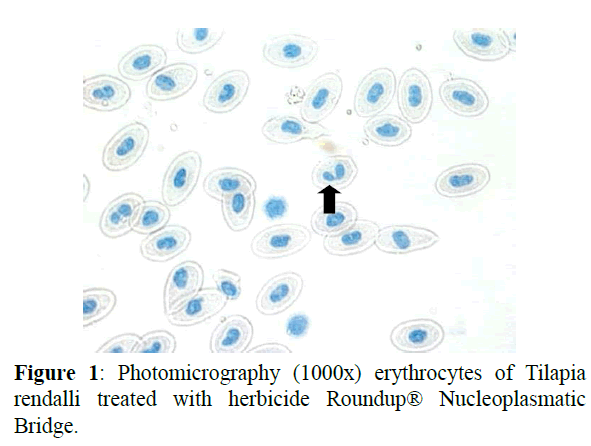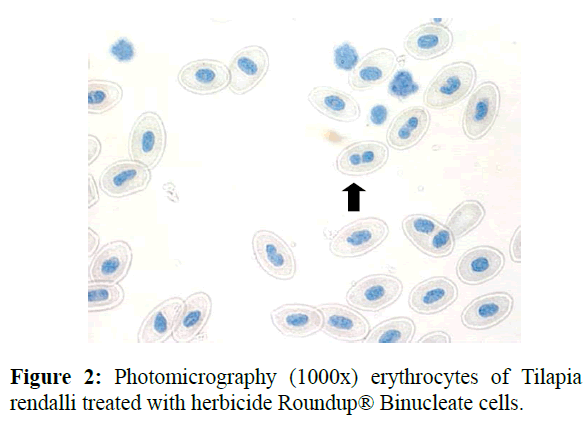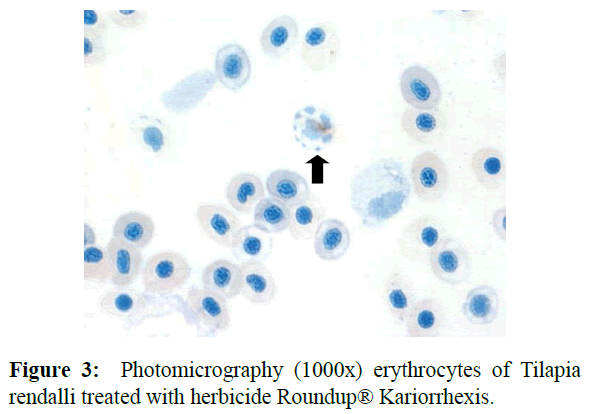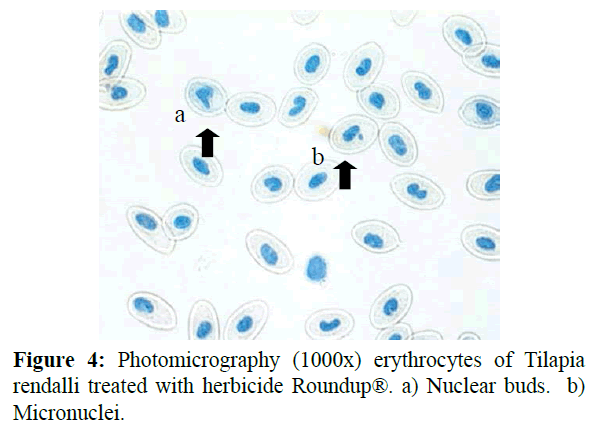Keywords
Micronuclei; Mutagenicity; Roundup; Tilápia; Herbicide
Introduction
Concern about the use of pesticides for agricultural production is increasingly frequent due to both the environmental impacts and the damage they can cause to living things. For example, Clements et al. (1997) observed the genotoxicity of five herbicides most commonly used in Canada in Rana Catesbeiana tissues. Among these, four demonstrated significant DNA damage, one of which is Roundup®. Monsanto's Roundup® herbicide is universally used in the practice of biological control of herbaceous plants in reforestation and agricultural plantations (Ross et al., 2005).
The genotoxicity of this herbicide is due to its active agent, glyphosate isopropylamine (C6H17H2O5P). Glyphosate is absorbed by the chlorophyll region of the plants and translocated, preferably by the phloem, to the meristematic tissues, thus acting as a potent inhibitor of the activity of 5 enolpyruvylshikimate 3 phosphate (EPSPS) which is a catalyst for one of the reactions. From syntheses of these aromatic amino acids; phenylalanine, tyrosine and tryptophan, which also influence other processes, such as inhibition of chlorophyll synthesis, stimulation of ethylene production and reduction of protein synthesis (Monsanto, 2005).
The experimental use of animals is used for in vitro testing for the evaluation of mutagenicity in live organisms, for example in freshwater environment, such as: Tilápia rendalli, Oreochromis niloticus, Chana punctatos, Cnesterodun decemmaculatus, Haplias malabaricus (Ahmad & Ahmad, 2015; Abdel-Khalek et al., 2015; Arcaute et al., 2016; Javed et al., 2016; El-Dien, 2009; Batista et al., 2016; Correia et al., 2017) are also widely used snails for environmental assessment as Biomphalaria alexandrina (Abdel–Gaffar, 2016; Ibrahim et al., 2018) and also vegetables such as Allium cepa (Hemanchandra & Pathiratne, 2016). Different techniques are also used for evaluation as a test of the MN, comet assay and directly verify DNA damage through electrophoresis gel.
Roundup® has also shown chromosomal effects, as Rank et al. (1993) observed a significant increase in chromosomal changes in onion cells during mitosis after treatment with Roundup® at concentrations of 1.44 and 2.88 mg. Grisolia et al., (2002) demonstrated an increase of micronucleated cells in tilapia cells exposed to different pesticides.
Biotechnological manipulations have created genetically modified organisms, such as transgenic RR soybeans resistant to the roundup herbicide, so this soybean usually receives a greater amount of glyphosate due to its resistance, and this compound can also contaminate the soil and aquatic environments. Thus, this work evaluated the frequency of micronuclei and other nuclear alterations in the peripheral blood of Tilapia rendalli exposed to the herbicide Roundup®.
Material and Methods
Experiment
In Brazil, the introduction of fish, mainly due to socio economic reasons, such as the Tilapia that comes from the Congo, has been occurring since 1956 (Gurgel & Fernando, 1994).
The experimental use of the animals was all according to the ethics committee of Centro de Ciências Médicas e Biológicas da Pontifícia Universidade Católica de São Paulo (CCMB-PUC SP). Therefore, 60 specimens of young Tilapia from 5 to 10 cm in size were purchased from fish farms in the region, which were kept in a number of 10 per aquarium containing approximately 50 litres of filtered water and aerated at a temperature of (23ºC ± 1°C). The fish were fed commercial feed and remained in these conditions for two weeks for acclimatisation.
During the experiment the 60 fish were divided into 6 aquariums, 2 control and 4 with 5 mg/L and 15 mg/L Roundup®. The time of exposure to the herbicide was 5 and 10 days, and the control fish remained in the aquarium with clean water during the same times.
Peripheral blood collection was done by cardiac puncture under anaesthesia with benzocaine 100 mg/L for approximately two minutes and with blood collected smears were made and fixed in absolute methanol for 15 minutes, air dried and stained with 15% Giemsa for 15 minutes.
Cell Count
The determination of the frequency of micronucleated erythrocytes was performed in a common optical microscope with the aid of the blind test immersion objective. Micronucleated erythrocytes in a total of 1000 erythrocytes per fish were identified according to the criteria established by Fenech et al. (2003), spherical corpuscles with a diameter between 1/3 and 1/20 of the size of the main nucleus, in the same plane of focus, completely separated and with the same cytochemical characteristics of nuclear chromatin, proposed by Heddle (1973) and Schmid (1975).
We consider it opportune to observe other types of nuclear alterations according to criteria established by Tolbert et al. (1992) such as: nuclear buds, binucleate cells, nucleoplasmic bridges, karyorhexis and karyolysis). The results were submitted to Kruskal-Wallis non-parametric statistical test (Ayres et al., 2000).
Results
The results obtained in our experiment demonstrated that the frequency of micronucleated erythrocytes in peripheral blood of Tilapia rendalli exposed to 5 and 15 mg/L of Roundup® herbicide during 5 and 10 days was higher, but statistically not significant (p>0.05) in relation to control (Table 1).
| Time of Exposure |
Concentration (mg/l) |
nº Individuals |
MNª |
ONAb |
| 5 days |
0 |
10 |
0.21 |
0.38 |
| 10 days |
0 |
10 |
0.19 |
0.26 |
| 5 days |
5 |
10 |
0.37 |
0.95* |
| 10 days |
5 |
10 |
0.46 |
0.75* |
| 5 days |
15 |
10 |
0.48 |
0.76* |
| 10 days |
15 |
10 |
0.3 |
0.52* |
*= Significance compared to control group (p<0.05) Kruskal Wallis test.
ª = Micronuclei/1000 cells (%).
b = Other Nuclear Alterations/1000 cells (%) (Nuclear buds, binucleate cells,
nucleoplasmic bridges, karyorrhexis and karyolysis).
The frequency of cells with other nuclear alterations (Figures 1-4) showed higher and with significant differences in relation to the control (p<0.05) at concentrations of 5 and 15 mg/L for 5 and 10 days as can be seen in Table 1.

Figure 1: Photomicrography (1000x) erythrocytes of Tilapia rendalli treated with herbicide Roundup® Nucleoplasmatic Bridge.

Figure 2: Photomicrography (1000x) erythrocytes of Tilapia rendalli treated with herbicide Roundup® Binucleate cells.

Figure 3: Photomicrography (1000x) erythrocytes of Tilapia rendalli treated with herbicide Roundup® Kariorrhexis.

Figure 4: Photomicrography (1000x) erythrocytes of Tilapia rendalli treated with herbicide Roundup®. a) Nuclear buds. b) Micronuclei.
Discussion
The results of the present study were similar to those reported in previous publications, like Grisolia et al., 2002. Grisolia, (2002) demonstrated significant differences (p<0.05) in the frequency of micronucleated erythrocytes in Tilapia rendalli, treated with different concentrations of Roundup® (42, 85 and 170 mg/kg). Williams et al. (1999) report that Roundup® in low concentrations poses no real risk to humans, but applicators and children from 1 to 6 years of age are potentially at risk from exposure.
In further studies with tilapia, in the review by Alvarez-Moya et al. (2014), the frequency of micronuclei in exposed individuals is somewhat higher. However, it does not compare to in vitro experiments, and the exposure is quite straightforward. Dias et al. (2005), reports that the in vitro micronucleus test has contributed greatly to the study of genotoxic agents. This article also suggests that the minimum concentration for the genotoxicity of glyphosate is about 12 mg/L. It is worth mentioning that studies focused on the frequency of micronuclei in fish erythrocytes are different in comparison to other organisms due to their metabolic difference.
The results obtained in our research demonstrated that the Roundup® herbicide caused a nonsignificant increase of Tilapia rendalli micronucleated erythrocytes exposed at concentrations of 5 and 15 mg/L for 5 and 10 days. However, it was possible to observe a significant increase of other nuclear alterations in concentrations of 5 and 15 mg/L in periods of 5 and 10 days of exposure to the herbicide. This fact was also observed by other researchers and indicative of genotoxic actions of the exposed animals.
Conclusion
As in other studies done with Roundup®, this clearly demonstrated genotoxic exposure to fish erythrocytes at different concentrations and times of exposure. This data could help standardise a threshold for herbicide use and avoid contamination in aquatic ecosystems, hence human.
Conflict of Interest Statement
The authors declare that they have no conflict of interest.
Acknowledgments
Thanks to Prof. Dr. Luciano Castanho for assigning his laboratory for this research, Leonardo Teixeira, Elcio Vasquez, Natasha dos Reis and Luciana Ramos for help in the development of the project and purchase of materials for the laboratory and Priscila Nanni for providing space for stocks of fishes. Thanks also to Professors Dr. Julio Boschini-Filho and Dr. Renata Manelli-Oliveira for the guidance of this work and to Edward Allan Nicholson for correcting the English of this work.
22140
References
- Ahmad, I., Ahmad, M. (2016) Fresh water fish, Channa punctatus, as a model for pendimethalin genotoxicity testing: A new approach toward aquatic environmental contaminants. Environ Toxicol (United States) 31, 1520-1529.
- Abdel-Ghaffar, F., Ahmed, A.K., Bakry, F., Rabei, I., Ibrahim, A. (2016) The Impact of Three Herbicides on Biological and Histological Aspects of Biomphalaria alexandrina, Intermediate Host of Schistosoma mansoni. Malacologia 59, 197-210.nnAbdel-Khalek, A.A., Badran, S.R., Marie, M.A. (2016) Toxicity evaluation of copper oxide bulk and nanoparticles in Nile tilapia, Oreochromis niloticus, using hematological, bioaccumulation and histological biomarkers. Fish Physiol Biochem (Netherlands) 42, 1225-1236.
- Alvares-Moya, C., Silva, M.R., Ramirez, C.V., Gallardo, D.G., Sánchez, R.L. (2014) Comparison of the in vivo and in vitro genotoxicity of glyphosate isopropylamine salt in three different organisms. Genetics Mol Biol 37, 105-110.
- Ayres, M., Ayres, Jr. M., Ayres, D.L., Santos, A.A.S. (2000) Bio Estat 2.0–Aplicações estatísticas nas áreas das ciências biológicas e médicas. Sociedade Civil Mamirauá. Manaus p: 193.
- Batista, N.J., de Carvalho Melo Cavalcante, A.A., de Oliveira, M.G, Medeiros, E.C., Machado, J.L., et al. (2016) Genotoxic and mutagenic evaluation of water samples from a river under the influence of different anthropogenic activities. Chemosphere (England) 164, 134-141.nnClements, C., Ralph, S., Petras, M. (1997) Genotoxicity of select herbicides in Rana catesbeiana tadpoles using the alkaline single-cell gel DNA electrophoresis (comet) assay. Envoron Mol Mutagen 29, 277-288.
- Correia, J.E., Christofoletti, C.A., Ansoar-Rodriguez, Y., Guedes, T.A., Fontanetti, C.S. (2017) Comet assay and micronucleus tests on Oreochromis niloticus (Perciforme: Cichlidae) exposed to raw sugarcane vinasse and to phisicochemical treated vinasse by pH adjustment with lime (CaO). Chemosphere 173, 494-501.
- De Ross, A.J., Blair, A., Rusiecki, J.A., Svec, M., Dosemeci, M. et al. (2005) Cancer incidence among glyphosate-exposed pesticide applicators in the agricultural health study. Environ. Health Perspect 113, 49-54.
- Dias, V.M., Manielli-Oliveira, R., Machado-Santelli, G.M. (2005) Using fluorescence for improvement of the quantitative analysis of micronucleus in cell culture. Mutat Res 565, 173-179.
- Fenech, M., Chang, W.P., Kirsch-Volders, M., Holland, N., Bonassi, S., et al. (2003) HUMN project: detailed description of scoring criteria for cytokinesis-block micronucleus assay using isolated human lymphocyte cultures. Mutat Res 534, 65-75.
- Grisolia, C.K.A (2002) comparison between mouse and fish micronucleus test using cyclophosphamide, mitomycin C and various pesticides. Mutat Res 518, 145-150.
- Gurgel, J.J.S., Fernando, C.H. (1994) Fisheries in semi-arid Northeast Brazil with special references to the role of tilapias. Int Revue ges Hydrobiol 79, 77-71.
- Heddle, J.A.A (1973) Rapid in vivo test for chromosome damage. Mutat Res 18, 187-192.
- Hemachandra, C.K., Pathiratne, A. (2017) Cytogenotoxicity screening of source water, wastewater and treated water of drinking water treatment plants using two invivo test systems: Allium cepa root based and Nile tilapia erythrocyte based tests. Water Res (England) 108, 320-329.
- Ibrahima, A.M., Kamal Ahmed, A., Bakrya, F.A., Abdel-Ghaffar F (2018) Hematological, physiological and genotoxicological effects of Match 5% EC insecticide on Biomphalaria alexandrina snails. Ecotoxicol Environ Safety 147, 1017-1022.
- Javed, M., Ahmad, I., Ahmad, A., Usmani, N., Ahmad, M., et al. (2016) Studies on the alterations in haematological indices, micronuclei induction and pathological marker enzyme activities in Channa punctatus (spotted snakehead) perciformes, channidae exposed to thermal power plant effluent. Springerplus 5, 761.
- Rank, J., Jensen, A.G., Skov, B., Pedersen, L.R., Jensen, K. (1993) Genotoxicity of the herbicide Roundup and its active ingredient glyphosate isopropylamine using the mouse bone marrow micronucleus test, Salmonella mutagenicity test, and Allium anaphase-telophase test. Mutat Res 300, 29-36.
- Williams, G.M., Kroes, R., Munro, I.C. (2000) Safety Evaluation and risk assessment of the herbicide Roundup and its active ingredient, glyphosate, for humans. Reg Tox Pharma 31, 117-165.










